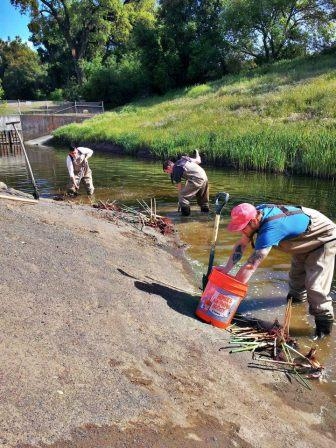Posts Tagged: campus
Ever Seen a Honey Bee Foraging on a Daffodil?
Ever seen a honey bee foraging on a daffodil? In the early spring, blooms are few and far between. Daffodils are not usually considered "bee...
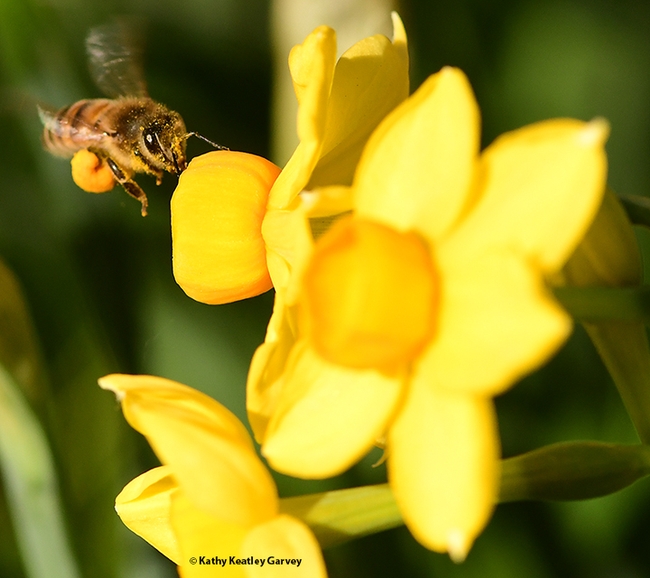
A pollen-packing honey bee heads a patch of daffodils on the UC Davis campus. (Photo by Kathy Keatley Garvey)
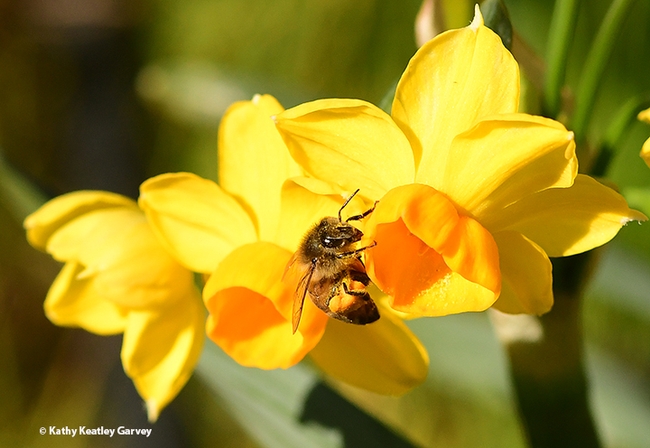
A honey bee adjusts her load of pollen. (Photo by Kathy Keatley Garvey)
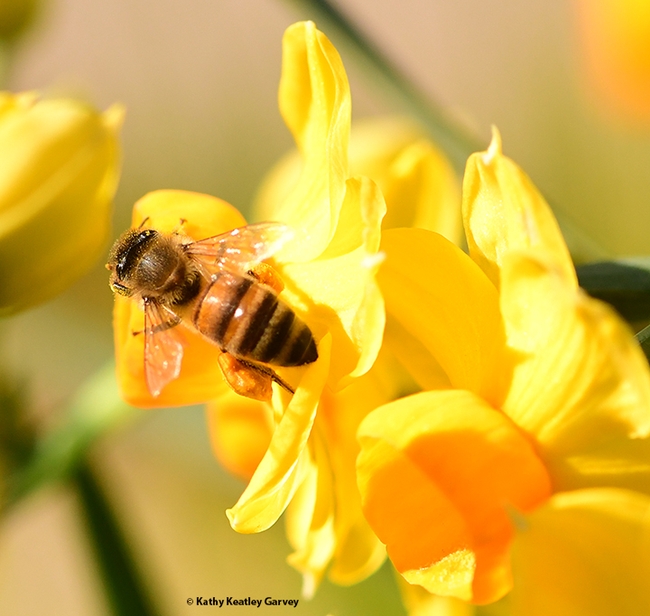
A golden honey bee with a load of golden pollen from golden daffodils. (Photo by Kathy Keatley Garvey)
College students create wildlife habitats in a Wild Campus program
Put together a group of hard-working, do-good college students who care about environmental issues, and you end up with a really “Wild Campus.” At UC Davis, students formed the student-run Wild Campus organization two years ago to conserve wildlife in the greater UC Davis area.
Working with campus experts (such as faculty and staff in the Department of Wildlife, Fish and Conservation Biology) and local environmental and conservation organizations, the volunteer students are improving the habitats for local wildlife and engaging the public in hands-on activities.
This is an extraordinary program that gives the students real-world environmental management skills, along with leadership opportunities and communications experience. Professor John Eadie, Department of Wildlife, Fish and Conservation Biology at UC Davis, said of the Wild Campus program, “Hands-on activity is a huge part of the educational experience.”
In the UC Davis Putah Creek Riparian Reserve, the students are establishing wildlife habitat areas and monitoring populations of amphibians, birds, fish, insects, mammals, and reptiles. They will record the changes over the course of time. Recent work in the riparian reserve (aka “the living classroom”) has included planting native oak seedlings, and installing tule plants to provide protection for the Western Pond Turtle, a species of concern.
A past project — Build a Wild Home Day — involved working with the UC Davis Arboretum on a successful public outreach program to build bird and bat boxes for installation on campus. (Great photos of this program are on the group’s Facebook page.)
The Wild Campus organization has a large cadre of eager and dedicated students who are improvising and making the most of limited resources. However, they are in need of donated field equipment (used equipment is fine) and financial contributions.
Visit the Wild Campus website and Facebook page for a feel-good look at what these ambitious students are doing to improve the environment, along with ways you can help them succeed.
Make a Nice Impression
As I have been to the UC Davis campus quite a bit in the last month, I have really appreciated how thoughtfully the landscaping has been designed and maintained. There is an abundance of bush roses, many ornamental grasses and so many different trees, it is a bit overwhelming. In the last couple of weeks, one particular plant has caught my attention more than once. I finally stopped my car the other day, and got out and photographed the plant. Later on that same day, I happened to be walking by a stunning border of very healthy perennials and there it was again. Fortunately for me, this specimen had a label. It sure is nice to run across a designed garden space where someone(s) has taken the time to label each and every plant with both the botanical and common names. Thank you, UC Davis Arboretum staff.
My mystery plant is Hesperaloe parviflora, commonly known as Red Yucca, although this plant is not a yucca at all. It happens, that at the moment, I am trying to better understand more about yuccas in general, so perhaps that is why I was attracted to this plant, but that will be another story. This Red Yucca has flowers that are not really red either. They are really more of a warm rose-coral color. An additional confusion: online sources, the Native Plant Database and the Texas Native Shrub database, both listed this plant as a member of the Agavaceae Family (Century Plant Family) with many common names including: Red Yucca, Coral Yucca, Red flowered false yucca, Redflower false yucca, Samandoque, and Yellow yucca. However, the newest Sunset Western Garden Book listed this plant in the Asparagaceae family. My Wait Manual unfortunately doesn’t list this plant at all. So, I will do some more checking down the road.
Although my sources don’t seem to agree on a family grouping, they do agree that it is not a yucca although it shares many physical characteristics of a yucca. In general, the yucca is described as producing huge clusters of bell-shaped flowers above upright, sword-like leathery leaves in large evergreen rosettes. The Red yucca produces soft, yucca-like, evergreen leaves, 2 to 3 feet in length, crowded on a short woody base. The flower stalk extends to 5 feet above the leaves with a clustering of coral tubular flower on arching, pink stems. The leaves are plum colored in winter and blue-green during the rest of the year. The leaves are simple and linear with parallel venation and form a basal rosette. It blooms March through July. This plant is drought resistant and both heat and cold tolerant as well as adaptable to a variety of soils. I can say from my observations that these plants are hummingbird magnets. The coral color is very cheerful and adds a nice breezy touch to a mostly green landscape. Sunset recommends these plants as good container specimens and I may just take them up on that suggestion next to my newly espaliered bougainvillea. What a nice impression that could be next summer.

Hesperaloe parviflora. (photo by Trish Rose)
Glow in the Dark White Garden
It’s a pleasure to look out my upstairs bedroom window on dark summer nights. I look down on two beautiful white rose bushes growing in my neighbor’s garden across the street. Any time there’s a moon they become luminous. They truly glow in the dark!
Anyone who has access to the UCD Arboretum on a moonlit summer night can share my neighborhood experience on a much larger scale. A walk through the “ Carolee Shields White Garden” near the west end of the arboretum is a magical experience, made more so when there’s a full moon. Designed in the style of a Japanese Moon Garden it’s also the location of a lovely gazebo, popular for weddings.
White flowers of many varieties bloom in all seasons. They’re beautiful in the daylight too, of course, but moonlight sets the White Garden apart from all the other themed Arboretum landscapes. Its ethereal loveliness is worth the trip to the UCD campus.
It’s a bit of a walk out there, depending on where you leave your car, and somewhat remote from main campus areas. A flashlight and a companion are necessities, and selecting a night when the moon is expected to be especially bright is a plus!

UC Davis Arboretum White Flower Garden sign. (photo by Marime Burton)
A Banner Day
First it was the California poppies. Then the lupine.And now it's coreopsis, aka tickseed.It's seasonal blooming at the Campus Buzzway, a...
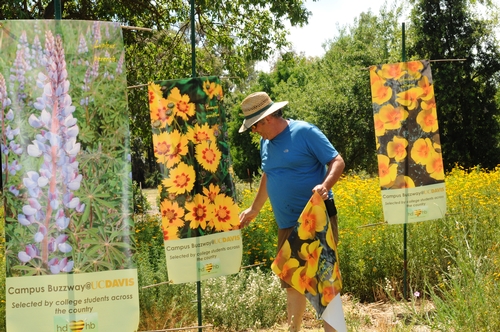
Trio of Banners

Coreopsis

Bee on Coreopsis



